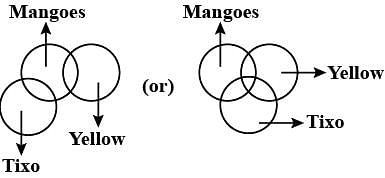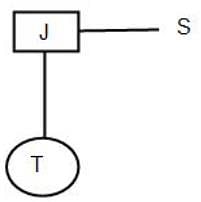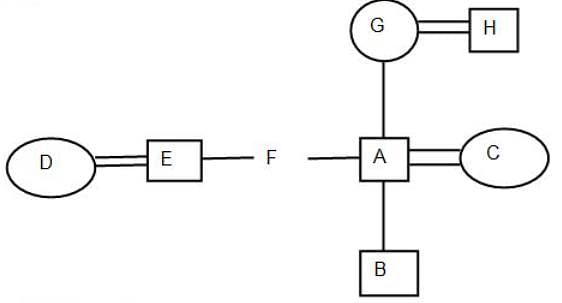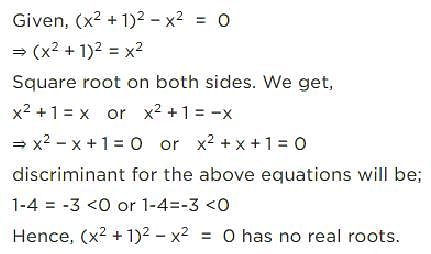EMRS Accountant Mock Test - 2 - EMRS MCQ
30 Questions MCQ Test EMRS Accountant Exam Mock Test Series 2024 - EMRS Accountant Mock Test - 2
Statements:
All the pencils are pens.
All the pens are inks.
Conclusions:
1. All the pencils are inks.
2. Some inks are pencils.
All the pencils are pens.
All the pens are inks.
1. All the pencils are inks.
2. Some inks are pencils.
Statements:
Some mangoes are yellow.
Some tixo are mangoes.
Conclusions:
(1) Some mangoes are green.
(2) Tixo is a yellow.
Some mangoes are yellow.
Some tixo are mangoes.
(1) Some mangoes are green.
(2) Tixo is a yellow.
| 1 Crore+ students have signed up on EduRev. Have you? Download the App |
Direction: Study the following information carefully to answer the given questions:
If 'A () B' means 'B is the mother of A'
If 'A of B' means 'B is the father of A'
If 'A ÷ B' means 'B is the sister of A'
If 'A × B' means 'B is the brother of A'
If 'A + B' means 'B is the daughter of A'
If 'A - B' means 'B is the son of A'
Q. If 'P of Q + R' is given, then which of the following is true?
Direction: Study the following information carefully to answer the given questions:
If 'A () B' means 'B is the mother of A'
If 'A of B' means 'B is the father of A'
If 'A ÷ B' means 'B is the sister of A'
If 'A × B' means 'B is the brother of A'
If 'A + B' means 'B is the daughter of A'
If 'A - B' means 'B is the son of A'
Q. If 'S x J + T' is given then which of the following is true?
Directions: Study the following information carefully to answer the given Questions:
P^Q-P is the child of Q
P!Q-P is the parent of Q
P*Q - P is elder to Q
P#Q-P is younger to Q
P@Q-P is brother of Q
P&Q - P is wife of Q
P+Q-P is sister-in-law of Q
Q. If A!B^C+D&E@F^G!A, if B is the son of C, then how is A related to B?
Sarita leaves from home .She walk 25m in North west direction and then 25m in south west direction.Next she walks 25m in south east direction.Finally she turn toward her house.Now in which direction she was moving ?
If 3’o clock in a watch.If the minute hand points towards the North east then the hour hand will point towards
P, Q, R and S are four males. P is the eldest in the group but he is not the poorest, R is the richest but not the eldest, Q is elder than S but he is not elder than P or R, P is richer than Q but he is not richer than S. How the four persons can be arranged in decreasing order of their age and money ?
In a cricket team, Dhoni is taller than Virat but not as tall as Raina, Rohit is shorter than Dhoni but taller than Shikhar. Who among them is the shortest ?
Read the following information carefully to answer the questions that follow.
I. Anita, Mahima Rajan, Lata, and Deepti are five cousins.
II. Anita is twice as old as Mahima.
III. Rajan is half the age of Mahima.
IV. Anita is half the age of Deepti.
V. Rajan is twice the age of Lata
Who is the youngest ?
The volume of a gas is directly proportional to temperature and inversely proportional to pressure. If the gas occupies 400 cubic feet volume at some pressure, then by what percentage does the pressure need to be increased so as to compress the gas into a 4 cubic feet tank at constant temperature?
The manager of a circus decides to buy some animals for the show. He buys 10 giraffes costing as much as 24 dogs, 16 dogs costing as much as 4 oxen and 6 oxen costing as much as 4 elephants. If the cost of 10 elephants is Rs. 1,70,000, what is the cost of a giraffe?
A man has some hens and cows. If the number of heads be 48 and the number of feet equals 140, then the number of hens will be:
If p = – 7 and q = 12 and x2+px+q=0, then the value of ‘x’ is
The roots of a quadratic equation x2−4px+4p2−q2=0 are
If a = -2 and b = -5 then find the value of a3 + b3– a2 + b2 + 2a – 3b
The average marks of a group of 20 students on a test is reduced by 4 when the topper who scored 90 marks is replaced by a new student. How many marks did the new student have?
Two cars started simultaneously towards each other and met each other 3 h 20 min later. How much time will it take the slower car to cover the whole distance if the first arrived at the place of departure of the second 5 hours later than the second arrived at the point of departure of the first?
Kamal started a business investing Rs 9000. After five months, Sameer joined with a capital of Rs 8000. If at the end of the year, they earn a profit of Rs. 6970, then what will be the share of Sameer in the profit ?
A tap can fill a tank in 4 hours. After half the tank is filled, two more similar taps are opened. What is the total time taken to fill the tank completely?
Three pipes A, B and C can fill a tank in 6 hours. After working at it together for 2 hours, C is closed and A and B can fill the remaining part in 7 hours. The number of hours taken by C alone to fill the tank is:
A sum of money amounts to Rs.9800 after 5 years and Rs.12005 after 8 years at the same rate of simple interest. The rate of interest per annum is
If the diameter of a cylindrical drum is 1.5 m and the height is 1.5 m, then maximum how many smaller aluminium cylindrical cans can be completely filled by the liquid in the cylindrical drum, if the radius and height of each can are 0.2 metres and 0.4 metres, respectively?
In a cricket match Kumble took three wickets less than twice the number of wickets taken by Srinath. The product of the number of wickets taken by these two is 20, then the number of wickets taken by Kumble is
Henry Varnum Poor, editor of American Railroad Journal, drew the important elements of the image of the railroad together in 1851, ―Look at the results of this material progress, the vigor, life, and executive energy that followed in its train, rapidly succeeded by wealth, the refinement and intellectual culture of a high civilization. All this is typified, in a degree, by a locomotive. The combination in its construction of nice art and scientific application of power, its speed surpassing that of our proudest courser, and its immense strength, are all characteristic of our age and tendencies. To us, like the telegraph, it is essential, it constitutes a part of our nature, is a condition of our being what we are.
In the third decade of the nineteenth century, Americans began to define their character in light of the new railroads. They liked the idea that it took special people to foresee and capitalize on the promise of science. Railroad promoters, using the steam engine as a metaphor for what they thought Americans were and what they thought Americans were becoming, frequently discussed parallels between the locomotive and national character, pointing out that both possessed youth, power, speed, single-mindedness, and bright prospects.
Poor was, of course, promoting acceptance of railroads and enticing his readers to open their pocketbooks. But his metaphors had their dark side. A locomotive was quite unlike anything Americans had ever seen. It was large, mysterious and dangerous; many thought that it was a monster waiting to devour the unwary. There was a suspicion that a country founded upon Jeffersonian agrarian principles had bought a ticket and boarded a train pulled by some iron monster into the dark recesses of an unknown future.
To ease such public apprehensions, promoters, poets, editors, and writers alike adopted the notion that locomotives were really only ―iron horses,‖ an early metaphor that lingered because it made steam technology ordinary and understandable. Iron horse metaphors assuaged fears about inherent defects in the national character, prompting images of a more secure future, and made an alien technology less frightening, and even comforting and congenial.
Essayist Ralph Waldo Emerson saw the locomotive as an agent of domestic harmony. He observed that ―the locomotive and the steamboat, like enormous shuttles, shoot every day across the thousand various threads of national descent and employment and bind them fast in one web,"adding ―an hourly assimilation goes forward, and there is no danger that local peculiarities and hostilities should be preserved. To us Americans, it seems to have fallen as a political aid. We could not else have held the vast North America together, which we now engage to do."
Direction: Read the above Paragraph and answer the following Questions
Q. Suppose that an early nineteenth-century American inventor had developed a device that made it easier to construct multi-story building. How would early nineteenth-century Americans be expected to react to this invention?
Directions: Spot the error in the underlined part of the sentence and choose the correct sentence accordingly.
Though subjected to varying influences, the distinctive features of China's artistic activity possess a unity which is quite as complete as that of our Western art.
Directions: Spot the error in the underlined part of the sentence and choose the correct sentence accordingly.
In the fission reactions that nuclear power generation rely on today, heavy elements breaks into smaller ones.































